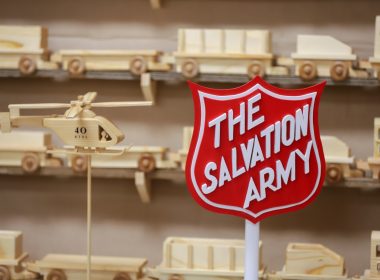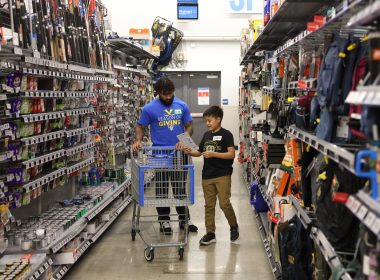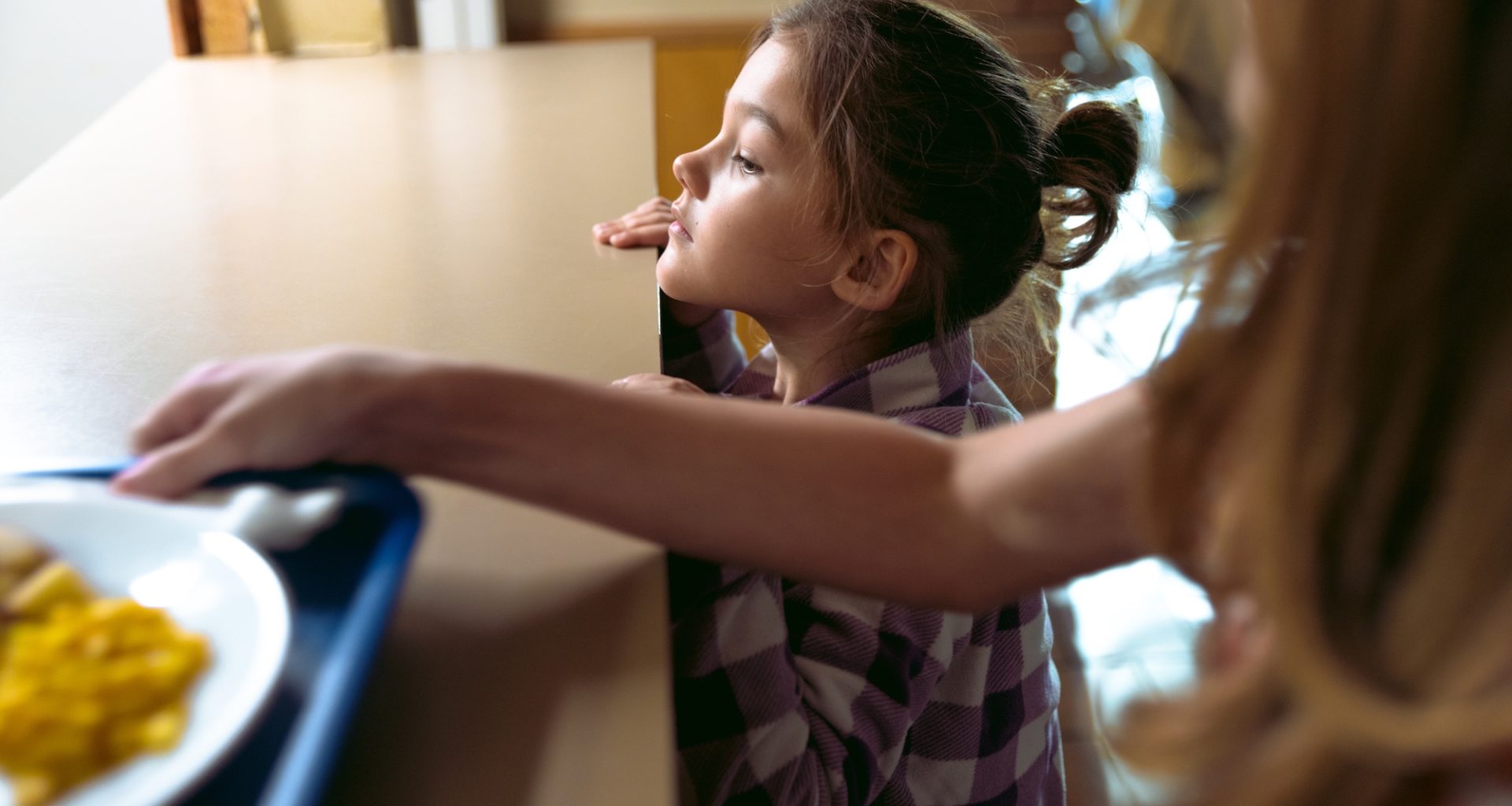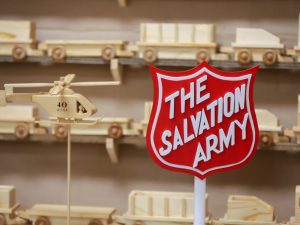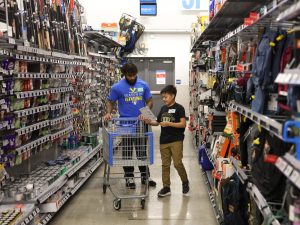The evening of Jan. 7 began like many others at the Helms household in Pasadena, California. Salvation Army Captains Nicholas and Rebecca Helms and their four children had just finished dinner and were settling into their evening activities.
Suddenly, then 9-year-old Drew announced he could see a fire outside his window.
“At first, we thought he was joking, and told him it wasn’t funny,” Rebecca Helms said.
In just minutes, though, they were part of a mass evacuation order affecting tens of thousands of people in the Pasadena-Altadena area for what would later be named the Eaton Fire—one of two major wildfires that scorched the LA area in January 2025.
“As we were leaving…all of our kids are crying and I am trying to keep them all calm and reminding them everything in our house is replaceable,” Helms said. “The most important thing is that we’re together and mommy and daddy are going to do everything we can to make sure our family is safe.”
As Corps Officers (pastors) of The Salvation Army Pasadena Tabernacle Corps, the Helmses headed to the corps as part of their role is to serve others during uncertain times.
When disasters strike, The Salvation Army responds quickly, ensuring individuals and families have what they need to feel safe by meeting immediate needs like food and shelter, and offering emotional and spiritual care.
According to the National Center for Disaster Preparedness, one measure of the strength of a community’s response and recovery system is its attentiveness to its most vulnerable citizens—beginning with children.
Dr. Kevin Ellers has served countless families following disaster situations as Territorial Emergency/Disaster Services (EDS) Director for The Salvation Army in the central U.S.
“The Salvation Army’s philosophy has always been—and it is true—that when you help the parents, then that stabilizes the kids,” he said. “A lot of times we don’t understand how much meeting basic needs brings the parents’ stress levels down. And then if the kids feel like mom and dad are OK, then they’re more likely to look to that adult and say, ‘then I’m OK, right?’”
When a disaster moves beyond the immediate relief phase into recovery, The Salvation Army continues to serve families. By assisting with children’s school essentials—new clothes, supplies and haircuts—The Salvation Army’s ongoing support further relieves parental stress and helps families regain stability.
Additionally, The Salvation Army offers programs specifically for kids, creating a sense of order within a caring environment when the world has otherwise been turned upside down.
Captain David Cain, Spokane (Washington) County Coordinator and Corps Officer, has seen the impact of these programs after the Gray and Oregon Road fires tore through the county in 2023, destroying 366 homes and 710 structures—the largest loss of primary structures in the state’s history.
“Often the children of these families become collateral damage in the wake of these disasters,” he said. “The work of supporting families after a disaster is more than just pragmatic support. Compelled by God’s love, The Salvation Army meets the needs of the whole person—physical, emotional and spiritual.”
To help survivors, the Spokane Salvation Army hired four long-term case managers.
“We hit the ground running, meeting clients right where they were,” said Director of Business and Operations Andrea Reedy. “We allowed them to tell their story to us, learned about how their life was before the fire, how the fire affected them and then how we could help them along the way to recovery.”
“Simply being there, listening, allowing children to share their stories when they’re ready is powerful…The best approach is to create a space where they feel safe, heard and supported.”
Captain Rebecca Helms
The Anderson family—Cheyenna and Marc and their four children—lost their home to the fires. Since then, The Salvation Army has been assisting them.
Cain said the Anderson children were especially affected by the disaster.
“One important part of providing normalcy for their kids was offering them scholarships for a week at our Camp Gifford during the summer,” Cain said. “Not only did that provide the parents some opportunity to get work done on the home, it gave the kids an escape.”
When Cain met with the family after the summer, all the kids wanted to talk about was their time at camp. For the child too young to attend, the top priority? Getting back to the family’s property.
“Normalcy was accomplished by helping the family rebuild, clear trees, dig trenches and obtain the necessary construction resources,” he said.
Today, the Andersons live in a new manufactured home that sits on their old property while they continue to piece their life back together.
“I don’t know where we would be today, honestly, if we hadn’t gotten the help that we did from The Salvation Army,” Marc Anderson said.
Soon after the Spokane fires, a wildfire devastated the town of Lahaina in Maui, displacing thousands of people in August 2023. Today, most families have transitioned out of hotels into FEMA- or state-supported temporary housing, according to Envoy Kevin Nagasaki, In-Charge of the Lahaina Lighthouse Corps. He said finding permanent housing takes time. For many, construction is underway.
“Moving forward is the key thing,” he said. “Hotel living gets stagnant…It’s no place for kids.”
Nagasaki said as families move into temporary or permanent housing, The Salvation Army has been providing beds for kids, made possible by a donation. And as families re-establish themselves in neighborhoods, he’s seeing kids riding their bikes and skateboards, and making friends. There’s a sense of community.
“That’s what stabilizes families,” he said.
Back in Pasadena, the Helmses and their community are beginning the healing process. Four families in the congregation lost their homes to the fire. While families continue to grieve their loss, Rebecca Helms said that for the kids, maintaining a normal routine—especially with schools being closed for several weeks—was crucial.
Through it all, the corps helped provide stability with its youth programming.
”Every child who had been evacuated—or even lost their home—still showed up,” she said. “That sense of normalcy and community seems to be what they need most…They don’t want to be treated differently but will open up to a trusted adult when they feel safe.”
Helms said a strong community builds resiliency, and allows kids to freely share their feelings, knowing emotions will come in unexpected waves.
“Most of all, being with their friends—talking, playing and processing together—has been one of the most healing aspects,” she said. “The ministry of presence is key. Simply being there, listening, allowing children to share their stories when they’re ready is powerful…The best approach is to create a space where they feel safe, heard and supported.”
Do Good:
- See how The Salvation Army fights disaster.


